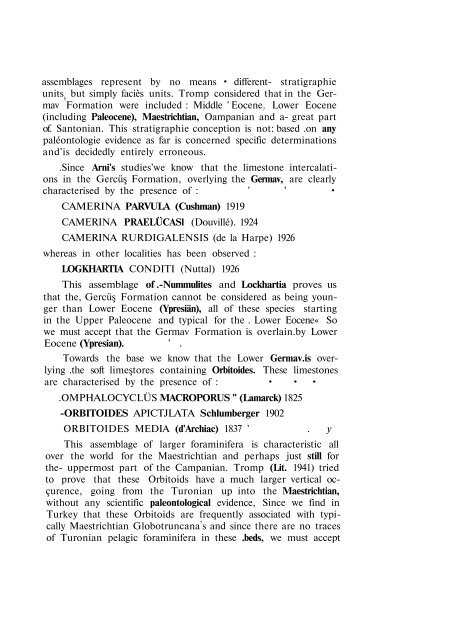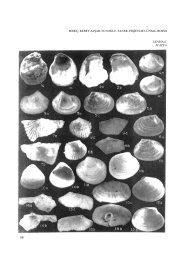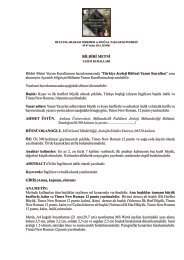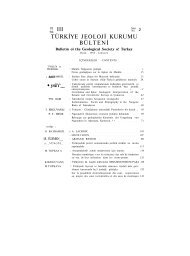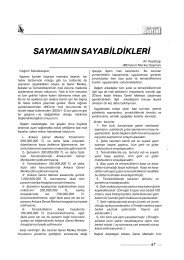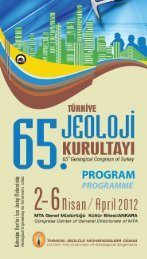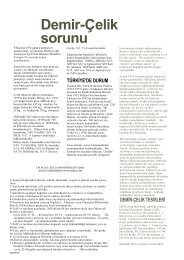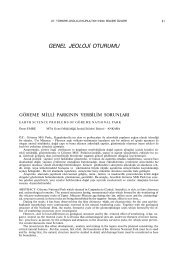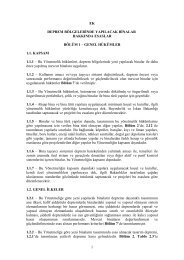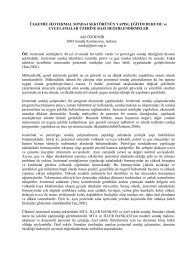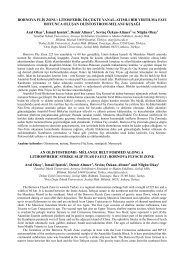Cenub DoÄu Türkiye'de Tersiyer-Kretase'Hududu
Cenub DoÄu Türkiye'de Tersiyer-Kretase'Hududu
Cenub DoÄu Türkiye'de Tersiyer-Kretase'Hududu
You also want an ePaper? Increase the reach of your titles
YUMPU automatically turns print PDFs into web optimized ePapers that Google loves.
assemblages represent by no means • different- stratigraphie<br />
units ş<br />
but simply faciès units. Tromp considered that in the Germav<br />
Formation were included : Middle ' Eocene ?<br />
Lower Eocene<br />
(including Paleocene), Maestrichtian, Oampanian and a- great part<br />
of. Santonian. This stratigraphie conception is not: based .on any<br />
paléontologie evidence as far is concerned specific determinations<br />
and'is decidedly entirely erroneous.<br />
.Since Arni's studies'we know that the limestone intercalations<br />
in the Gercüş Formation, overlying the Germav, are clearly<br />
characterised by the presence of : ' ' •<br />
CAMERINA PARVULA (Cushman) 1919<br />
CAMERINA PRAELÜCASl (Douvillé). 1924<br />
CAMERINA RURDIGALENSIS (de la Harpe) 1926<br />
whereas in other localities has been observed :<br />
LOGKHARTIA CONDITI (Nuttal) 1926<br />
This assemblage of .-Nummulites and Lockhartia proves us<br />
that the, Gercüş Formation cannot be considered as being younger<br />
than Lower Eocene (Ypresiän), all of these species starting<br />
in the Upper Paleocene and typical for the . Lower Eocene« So<br />
we must accept that the Germav Formation is overlain.by Lower<br />
Eocene (Ypresian). ' .<br />
Towards the base we know that the Lower Germav.is overlying<br />
.the soft limeştores containing Orbitoides. These limestones<br />
are characterised by the presence of : • • •<br />
.OMPHALOCYCLÜS MACROPORUS " (Lamarck) 1825<br />
-ORBITOIDES APICTJLATA Schlumberger 1902<br />
ORBITOIDES MEDIA (d'Archiac) 1837 ' . y<br />
This assemblage of larger foraminifera is characteristic all<br />
over the world for the Maestrichtian and perhaps just still for<br />
the- uppermost part of the Campanian. Tromp (Lit. 1941) tried<br />
to prove that these Orbitoids have a much larger vertical ocçurence,<br />
going from the Turonian up into the Maestrichtian,<br />
without any scientific paleontological evidence, Since we find in<br />
Turkey that these Orbitoids are frequently associated with typically<br />
Maestrichtian Globotruncana ? s and since there are no traces<br />
of Turonian pelagic foraminifera in these .beds, we must accept


